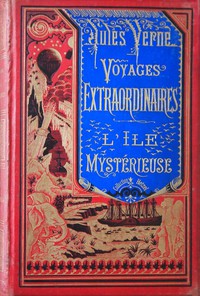The Mysterious Island by Jules Verne (ebook and pdf reader txt) 📖

- Author: Jules Verne
Book online «The Mysterious Island by Jules Verne (ebook and pdf reader txt) 📖». Author Jules Verne
After all, who knows if Jup and Top had not their dream of the future?
Ayrton, silent, said to himself that he wanted to see Lord Glenarvan, and show him the change in himself.
One evening, the 15th of October, the conversation was prolonged longer than usual. It was 9 o’clock, and already, long, ill-concealed yawns showed that it was bed-time. Pencroff was about starting in that direction, when, suddenly, the electric bell in the hall rang.
Every one was present, so none of their party could be at the corral.
Smith rose. His companions looked as if they had not heard aright.
“What does he want?” cried Neb. “Is it the devil that’s ringing?”
No one replied.
“It is stormy weather,” said Herbert; “perhaps the electric influence——”
Herbert did not finish the sentence. The engineer, towards whom all were looking, shook his head.
“Wait a minute,” said Spilett. “If it is a signal, it will be repeated.”
“But what do you think it is?” asked Neb.
“Perhaps it——”
The sailor’s words were interrupted by another ring.
Smith went to the apparatus, and, turning on the current, telegraphed to the corral:——
“What do you want?”
A few minutes later the needle, moving over the lettered card, gave this answer to the inmates of Granite House:—
“Come to the corral as quickly as possible.”
“At last!” cried Smith.
Yes! At last! The mystery was about to be solved! Before the strong interest in what was at the corral, all fatigue and need of repose vanished. Without saying a word, in a few minutes they were out of Granite House and following the shore. Only Top and Jup remained behind.
The night was dark. The moon, new this day, had set with the sun. Heavy clouds obscured the stars, but now and then heat-lightning, the reflection of a distant storm, illuminated the horizon.
But, great as the darkness was, it could not hinder persons as familiar with the route as were the colonists. All were very much excited, and walked rapidly. There could be no doubt that they were going to find the answer to the engineer, the name of that mysterious being, who was so generous in his influence, so powerful to accomplish! It could not be doubted that this unknown had been familiar with the least detail of their daily lives, that he overheard all that was said in Granite House.
Each one, lost in his reflections, hurried onward. The darkness under the trees was such that the route was invisible. There was no sound in the forest. Not a breath of wind moved the leaves.
This silence during the first quarter of an hour was uninterrupted, save by Pencroff, who said:——
“We should have brought a lantern.”
And by the engineer’s answer:——
“We will find one at the corral.”
Smith and his companions had left Granite House at twelve minutes past 9. In thirty-five minutes they had traversed three of the five miles between the mouth of the Mercy and the corral.
Just then, brilliant flashes of lightning threw the foliage into strong relief. The storm was evidently about to burst upon them. The flashes became more frequent and intense. Heavy thunder rolled through the heavens. The air was stifling.
The colonists rushed on, as if impelled by some irresistible force.
At a quarter past 9, a sudden flash showed them the outline of the palisade; and scarcely had they passed the gateway when there came a terrible clap of thunder. In a moment the corral was crossed, and Smith stood before the house. It was possible that the unknown being was here, since it was from this place that the telegraph had come. Nevertheless, there was no light in the window.
The engineer knocked at the door, but without response.
He opened it, and the colonists entered the room, which was in utter darkness.
A light was struck by Neb, and in a moment the lantern was lit, and its light directed into every corner of the chamber.
No one was there, and everything remained undisturbed.
“Are we victims to a delusion?” murmured Smith.
No! that was impossible! The telegraph had certainly said:——
“Come to the corral quickly as possible.”
He went to the table on which the apparatus was arranged. Everything was in place and in order.
“Who was here last?” asked the engineer.
“I, sir,” answered Ayrton.
“And that was——”
“Four days ago.”
“Ah! here is something!” exclaimed Herbert, pointing to a paper lying on the table.
On the paper were these words, written in English:——
“Follow the new wire.”
“Come on!” cried Smith, who comprehended in a moment that the dispatch had not been sent from the corral, but from the mysterious abode which the new wire united directly with Granite House.
Neb took the lantern and all left the corral.
Then the storm broke forth with extreme violence. Flashes of lightning and peals of thunder followed in rapid succession. The island was the centre of the storm. By the flashes of lightning they could see the summit of Mount Franklin enshrouded in smoke.
There were no telegraph poles inside the corral, but the engineer, having passed the gate, ran to the nearest post, and saw there a new wire fastened to the insulator, and reaching to the ground.
“Here it is!” he cried.
The wire lay along the ground, and was covered with some insulating substance, like the submarine cables. By its direction it seemed as if it went towards the west, across the woods, and the southern spurs of the mountain.
“Let us follow it,” said Smith.
And sometimes by the light of the lantern, sometimes by the illumination of the heavens, the colonists followed the way indicated by the thread.
They crossed in the first place, the spur of the mountain between the valley of the corral and that of Fall River, which stream was crossed in its narrowest part. The wire, sometimes hanging on the lower branches of the trees, sometimes trailing along the ground, was a sure guide.
The engineer had thought that, perhaps, the wire would end at the bottom of the valley, and that the unknown retreat was there.
But not so. It extended over the southwestern spur and descended to the arid plateau which ended that fantastic wall of basalt. Every now and then one or other of the party stooped and took the direction of the wire. There could be no doubt that it ran directly to the sea. There, doubtless, in some profound chasm in the igneous rocks, was the dwelling so vainly sought for until now.
At a few minutes before 10, the colonists arrived upon the high coast overhanging the ocean. Here the wire wound among the rocks, following a steep slope down a narrow ravine.
The colonists followed it, at the risk of bringing down upon themselves a shower of rocks or of being precipitated into the sea. The descent was extremely perilous, but they thought not of the danger; they were attracted to this mysterious place as the needle is drawn to the magnet.
At length, the wire making a sudden turn, touched the shore rocks, which were beaten by the sea. The colonists had reached the base of the granite wall.
Here there was a narrow projection running parallel and horizontal to the sea. The thread led along this point, and the colonists followed. They had not proceeded more than a hundred paces, when this projection, by a south inclination, sloped down into the water.
The engineer seized the wire and saw that it led down into the sea.
His companions stood, stupefied, beside him.
Then a cry of disappointment, almost of despair, escaped them! Must they throw themselves into the water and search some submarine cavern? In their present state of excitement, they would not have hesitated to have done it.
An observation made by the engineer stopped them. He led his companions to the shelter of a pile of rocks and said:——
“Let as wait here. The tide is up. At low water the road will be open.”
“But how do you think—” began Pencroff.
“He would not have called us, unless the means of reaching him had been provided.”
Smith had spoken with an air of conviction, and, moreover, his observation was logical. It was, indeed, quite possible that an opening existed at low water which was covered at present.
It was necessary to wait some hours. The colonists rested in silence under their shelter. The rain began to fall in torrents. The echoes repeated the roaring of the thunder in sonorous reverberations.
At midnight the engineer took the lantern and went down to the water’s edge. It was still two hours before low tide.
Smith had not been mistaken. The entrance to a vast excavation began to be visible, and the wire, turning at a right angle, entered this yawning mouth.
Smith returned to his companions and said:——
“In an hour the opening will be accessible.”
“Then there is one,” said Pencroff.
“Do you doubt it?” replied Smith.
“But it will be half full of water,” said Herbert.
“Either it will be perfectly dry,” answered the engineer, “in which case we will walk, or it will not be dry, and some means of transport will be furnished us.”
An hour passed. All went down through the rain to the sea. In these hours the tide had fallen fifteen feet. The top of the mouth of the opening rose eight feet above the water, like the arch of a bridge.
Looking in, the engineer saw a black object floating on the surface. He drew it toward him. It was a canoe made of sheet-iron bolted together. It was tied to a projecting rock inside the cavern wall. A pair of oars were under the seats.
“Get in,” said Smith.
The colonists entered the boat, Neb and Ayrton took the oars, Pencroff the tiller, and Smith, in the bows holding the lantern, lit the way.
The vault, at first very low, rose suddenly; but the darkness was too great for them to recognize the size of this cavern, its heighth and depth. An imposing silence reigned throughout this granite chamber. No sound, not even the pealing of the thunder penetrated its massive walls.
In certain parts of the world there are immense caves, a sort of natural crypts which date back to the geologic epoch. Some are invaded by the sea; others contain large lakes within their walls. Such is Fingal’s Cave, in the Island of Staffa; such are the caves of Morgat on the Bay of Douarnenez in Brittany; the caves of Bonifacio, in Corsica; those of Lyse-Fjord, in Norway; such is that immense cavern, the Mammoth Cave of Kentucky, which is 500 feet high and more than twenty miles long!
As to this cavern which the colonists were exploring, did it not reach to the very centre of the island? For a quarter of an hour the canoe advanced under the directions of the engineer. At a certain moment he said:——
“Go over to the right.”
The canoe, taking this direction, brought up beside the wall. The engineer wished to observe whether the wire continued along this side.
It was there fastened to the rock.
“Forward!” said Smith.
The canoe kept on a quarter of an hour longer, and it must have been half a mile from the entrance, when Smith’s voice was heard again.
“Halt!” he exclaimed.
The canoe stopped, and the colonists saw a brilliant light illuminating the enormous crypt, so profoundly hidden in the bowels of the earth.
They were now enabled to examine this cavern of whose existence they had had no suspicion.
A vault, supported on basaltic shafts, which might all have been cast in the same mould, rose to a height of 100 feet. Fantastic arches sprung at irregular intervals from these columns, which Nature had placed here by thousands. They rose to a height of forty or fifty feet, and the water, in despite of the tumult without, quietly lapped their base. The light noticed by the engineer seized upon each prismatic point and tipped it with fire; penetrated, so to speak, the walls as if they had been diaphanous, and changed into sparkling jewels the least projections of the cavern.
Following a phenomenon of reflection, the water reproduced these different lights upon its surface, so that the canoe seemed to float between two sparkling zones.
They had not yet thought of the nature of irradiation projected by the luminous centre whose rays, straight and clear, were broken on all the angles and mouldings of the crypt. The white color of this light betrayed its origin. It was electric. It was the sun of this cavern.
On a sign from Smith, the oars fell again into the water, and the canoe proceeded towards the luminous fire, which was half a cable’s length distant.
In this place, the sheet of water measured some 300 feet across, and an enormous basaltic wall, closing all that side, was visible beyond the luminous centre. The cavern had become much enlarged, and the sea here
 Have you ever thought about what fiction is? Probably, such a question may seem surprising: and so everything is clear. Every person throughout his life has to repeatedly create the works he needs for specific purposes - statements, autobiographies, dictations - using not gypsum or clay, not musical notes, not paints, but just a word. At the same time, almost every person will be very surprised if he is told that he thereby created a work of fiction, which is very different from visual art, music and sculpture making. However, everyone understands that a student's essay or dictation is fundamentally different from novels, short stories, news that are created by professional writers. In the works of professionals there is the most important difference - excogitation. But, oddly enough, in a school literature course, you don’t realize the full power of fiction. So using our website in your free time discover fiction for yourself.
Have you ever thought about what fiction is? Probably, such a question may seem surprising: and so everything is clear. Every person throughout his life has to repeatedly create the works he needs for specific purposes - statements, autobiographies, dictations - using not gypsum or clay, not musical notes, not paints, but just a word. At the same time, almost every person will be very surprised if he is told that he thereby created a work of fiction, which is very different from visual art, music and sculpture making. However, everyone understands that a student's essay or dictation is fundamentally different from novels, short stories, news that are created by professional writers. In the works of professionals there is the most important difference - excogitation. But, oddly enough, in a school literature course, you don’t realize the full power of fiction. So using our website in your free time discover fiction for yourself. 




Comments (0)